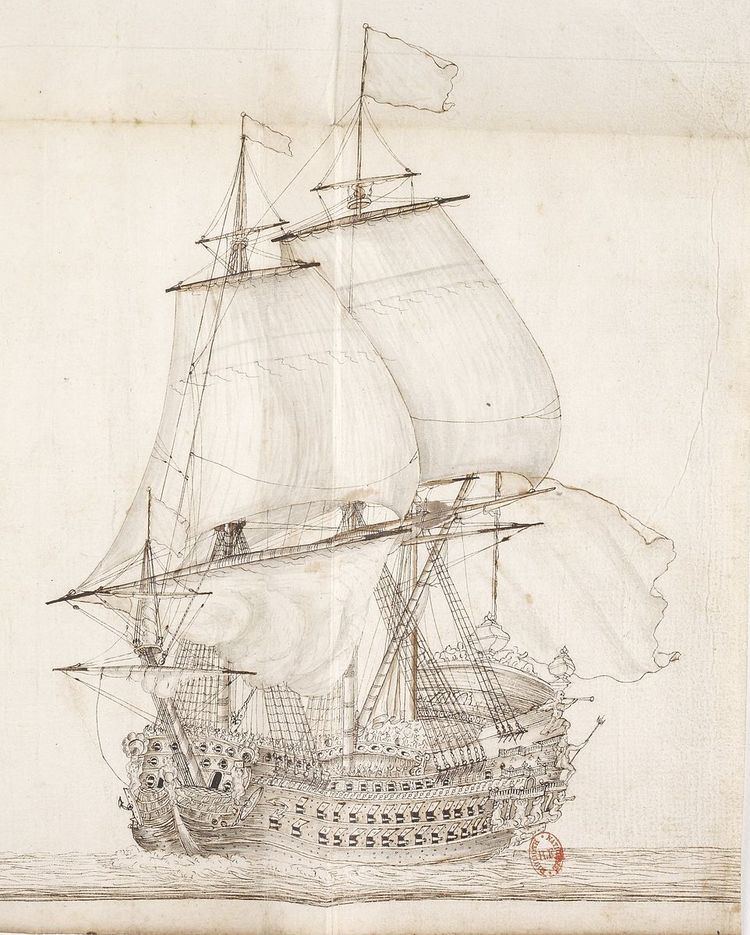Active 1689 – 1792 | Type Fleet | |
 | ||
Garrison/HQ Arsenal of ToulonArsenal of Galères | ||
The term Fleet of the Levant designated under the Ancien Regime the ensemble of naval vessels of the Royal French Navy (French: Marine royale française) destined for naval operations (naval supremacy, protection of convoys) in the Mediterranean. The fleet is the alter ego of the Flotte du Ponant (French: Flotte du Ponant), based in Manche and in the Atlantic.
Contents
Arsenals
First based in Fréjus, the fleet garrisoned at the beginning of the 17th century in two specialized aresenals:
Admiral Vessel
The Admiral Vessel (French: galère-amirale) is traditionally the Réale, bearing the mark of général des galères (grand-officer of the crown of France) (French: général des galères) is exposed at the Musée national de la Marine.
For the naval vessels, the Admiral Vessel was always the most powerful unit ship present in Toulon, under Louis XIV, the Royal-Louis of 110 cannons constructed in 1667 and in 1692 (vessels where the batteries were painted in red, the higher decks (French: gaillards) in blue and all underlined with dorure), and under Louis XVI the Majestueux (Majestic) of 110 cannons constructed in 1780 then the Commerce de Marseille of 118 cannons constructed in 1788.
Vice-admirals
The commandment of the two fleets ( Levant and du Ponant ) was entrusted on November 12, 1669 to two Vice-admirals.
In case Tourville commanded the fleet during the battles of the reign of Louis XIV, his successors would have hardly served at sea with such a senior age. The squadrons were confined during the 18th century to the Lieutenant Generals of the Naval Armies (French: lieutenants généraux des armées navales).
The rank lieutenant-general of the armies (French: Lieutenant-général des armées) or Lieutenant-general of the Naval Armies (French: lieutenant-général des armées navales) for la Marine, was the highest rank in the military hierarchy of the Ancien Regime, only accessible to nobility. He was only surpassed by the Marshals of France, the general colonels, for the Army, the Admirals of France and vice-admirals of France, for la Marine, titled not of a military rank but of a grand office of the French crown (French: grand office de la couronne de France), a dignity both honorific and lucrative. The rank of lieutenant general was the equivalent of the actual rank of division general and that of lieutenant-general of naval armies of the Vice-admiral of France.
The ranks of lieutenant-general of the armies were renamed as division general and vice-admiral in 1791. In 1814, the rank of division general was designated again as lieutenant general of the armies, before definitely being attributed the rank of general in 1848.
Administration
The Fleet of the Levant was re-baptized starting the French Revolution « escadre de la Méditerranée » ( squadrons of the Mediterranean ). The fleet was almost successively annihilated during the Siege of Toulon in 1793 and during the battles of Aboukir 1798 and Trafalgar.
The term of Fleet of the Levant was temporary readopted under the French Restoration and the July Monarchy.
The far distant actual descendent is the administration of the Commander-in-Chief, Mediterranean (French: Commandant en chef pour la Méditerranée)
